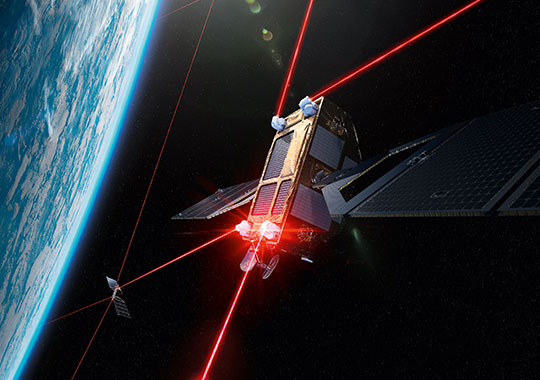 The unification of terrestrial, space and aerial platforms will be a key distinction between 5G and 6G networks. (Source: Shutterstock)
The unification of terrestrial, space and aerial platforms will be a key distinction between 5G and 6G networks. (Source: Shutterstock)
ALEXANDRIA, Va. — Given the challenges around the rollout of 5G, it’s understandable if the thought of 6G provokes a queasy feeling. But like seasickness, the best solution is to keep an eye on the horizon.
Today, researchers and innovators around the world are pressing forward with the design of a 6G framework that will be fundamentally different from previous generations of communications networks. This new architecture will have massive implications for the satellite industry.
In Europe, the European Commission has invested roughly €250 million into a handful of research and innovation projects for next-generation network technologies through the Smart Networks and Services Joint Undertaking (SNS JU). One of those is the sElf-evolving Terrestrial/non-terrestrial Hybrid nEtwoRks, or ETHER, a project launched in January to design a framework for a three-dimensional 6G terrestrial/non-terrestrial network architecture.
Dr. Konstantinos Ntontin, a research scientist at the University of Luxembourg, SnT and one of the lead coordinators of ETHER, explained that 6G will be a dramatic departure from earlier network architectures that were built to optimize terrestrial networks.
“The idea in 3GPP Release 17 was to incorporate non-terrestrial networks by using the already optimized functionalities of terrestrial networks,” he told Constellations. “But in terms of 6G networks, we follow a completely different approach. We consider a unified network that comprises three layers: the terrestrial layer, the aerial layer…and the satellite layer.”
This concept of a unified three-dimensional network architecture is widely accepted as the vision for 6G. Rather than shoehorning non-terrestrial networks (NTN) into a terrestrial framework, next-generation communication networks will emphasize cross-layer optimization. This will mean significant Radio Access Network (RAN) advances and the development of a common 6G network core, as well as the development and deployment of regenerative payloads, new waveforms and breakthroughs in network management and orchestration—all of which will be considered by ETHER throughout their three-year investigation.
Regenerative Payloads
One of the core pillars of a 6G architecture is a unified RAN that will enable mobile connectivity for handset devices anywhere on the globe using either a terrestrial, aerial or satellite platform. Accomplishing this will require simultaneous advances across RAN components, including elevating the idea of a base station.
For ETHER, the development of regenerative payloads is essential to the design of a unified terrestrial/non-terrestrial hybrid network. Unlike transparent payloads, where the signal is transmitted to the ground to be processed, regenerative payloads will enable the satellite to function as a base station. These payloads will perform onboard signal processing (modulation/demodulation, encoding/decoding, switching, beamforming, etc.) to transmit directly to a smartphone or other user equipment.
“This is very important,” Ntontin said, “because we want to provide the same functionalities as the terrestrial mobile network operators. We want these flying, aerial and space platforms as base stations.”
Leveraging on-orbit processing, regenerative payloads can unlock other critical 6G functionalities, like edge computing and caching. Moving workloads to space can help alleviate the burden on the terrestrial cloud and avoid costly, redundant data transmission, even with the size, weight and power constraints on orbit. Inter-satellite links (ISLs) or laser links, will be another feature of 6G payloads, which will help distribute data and tasks across constellations, while enabling multi-orbit and intra-orbit communication and containing the growth of new ground stations. Proliferated LEO constellations, like Starlink, are making use of ISLs and the U.S. government has advanced standards and is developing advanced optical communications technology for hybrid space communication.
 Regenerative payloads are seen as an enabler for inter-satellite links. (Source: Mynaric)
Regenerative payloads are seen as an enabler for inter-satellite links. (Source: Mynaric)
Regenerative payloads have been discussed widely and are expected to be a part of 3GPP’s Release 19. The technology has not yet been proven commercially but is progressing steadily heading into 2030 when the first commercial 6G specifications are scheduled for release.
A New 6G Waveform?
The challenge of enabling consumer mobile devices to access a unified RAN is also expected to force innovations in handset antennas as well as “virtual arrays” in low Earth orbit. These new antennas will support higher frequencies than the sub-6GHz bands used for 5G. Similarly, there are discussions of a new 6G waveform. Ideally, this will consider high-altitude, fast-moving non-terrestrial platforms and be better optimized for satellite links than today’s 5G OFDM carrier signals.
Spectrum allocation is still very much under consideration, with a few countries beginning to carve out additional mid-band frequencies for 6G. There are hopes that continuous advances in antenna technology will address some of the issues around spectrum scarcity, like interference and spectrum sharing. It’s generally expected that 6G will encompass frequencies between 7-24 GHz, with a terrestrial focus on upper mid-band frequencies between 7-16 GHz.
Vertical and Horizontal Handovers
The seamless handover (or handoff) among separate cells is what makes a mobile network truly mobile. While mobile network operators (MNOs) have largely solved handoff for two-dimensional or terrestrial networks, the complexities and timing difficulties will grow exponentially by adding a third dimension in the form of high-altitude platform systems (HAPS), drones and low Earth orbit satellites.
ETHER’s work on a unified RAN for terrestrial/non-terrestrial 6G networks will put particular emphasis on “seamless vertical and horizontal handovers,” Ntontin explained. Instead of users moving between stationary cells, handovers will occur between satellites moving up to 7.8 km per second (17,500 MPH), as well as among aerial, space and terrestrial platforms.
“We are talking about a highly dynamic network,” Ntontin continued. “Automation becomes crucial for the delivery and continued assurance of these highly diverse 6G services that are envisioned.”
Automation and Orchestration in the Teleport
Just as satellite payloads and antennas will need to evolve, so too will the ground segment. The teleport or gateway is an area where terrestrial advances can be put to use to enable a more seamless, flexible three-dimensional network, Ntontin explained. This becomes clearest in the transformation of hardware into more flexible, cost-effective, software-based functions.
“It all boils down to the automation and orchestrating of services that can be created by virtualization and softwarization,” he said of the changes needed in future teleports.
For years, the high cost of equipment and increasing demand for efficient services have pushed MNOs away from hardware-centric models toward network function virtualization and orchestration. 5G accelerated that transformation to the point that even core network functions can be instantiated and managed in a cloud environment.
Though solutions exist for cloud-based orchestration of a virtual teleport, the approach has not been adopted widely. “This is quite a nascent area in the satellite business,” Ntontin noted, but one that will fit “hand-in-hand with advancements that have already taken place in terrestrial networks.”
Networking Solutions with O-RAN and ETSI
By 2030, when the first 6G commercial launches are set to begin, nearly three-quarters of the world’s population will use mobile service, according to the GSMA. Almost two-thirds will be connected through mobile internet. The number of connected IoT devices worldwide will likely exceed 29 billion.
The combination of a massive number of data-hungry endpoints and a cellular network spanning from Earth to space, begs the essential question of managing these elements in a unified framework. This is where ETHER and other groups are exploring the concept of “zero-touch management and orchestration” leveraging the benefits of artificial intelligence and machine learning (AI/ML).
“We can’t rely on conventional, model-based approaches and the approaches we like of human supervision,” Ntontin emphasized. “In order to allocate optimally the resources, we need to provide some automated, machine learning-based frameworks.”
Like other groups, ETHER is working collaboratively with organizations and stakeholders to solve the challenges of automated network resource management within a virtualized, non-proprietary architectural framework. In particular, two industry partners of ETHER are members of the Open RAN (O-RAN) Alliance, a collaboration of industry and research partners developing specifications for next-generation radio access networks for AI/ML-enabled network management and orchestration. In contrast to its terrestrial counterpart, the work on a non-terrestrial ORAN framework remains in its early stages. However, it is viewed as a potential roadmap for the design of a unified terrestrial/non-terrestrial service management architecture.
Other efforts under consideration for future unified 6G architectures include the work of ETSI’s “Zero touch network and Service Management” (ZSM) group. Since 2017, ZSM has been advancing a framework for full end-to-end automation of network and service management. The group’s “ultimate automation target” is to enable networks that “will be capable of self-configuration, self-monitoring, self-healing and self-optimization without further human intervention.”
Intelligence Across Segments
Whether it’s edge computing, orchestrating virtual network functions or user equipment, every node in the next generation is getting smarter. This will continue to be the case leading into 6G where each point performs a specific function and contains the intelligence to coordinate its behavior within a unified network.
“In European Projects like ETHER, it is very important to have a clear use case for all the technology enablers under study during the project,” Sateliot CTO and Co-founder Marco Guadalupi and R&D Engineer Sergio Aguilar Romero told Constellations in an email.
Sateliot, the Spanish satellite IoT provider, is one of ETHER’s eight industry partners. It was brought into the consortium based on its contributing role in 3GPP’s NTN standard as well as its pioneering work in regenerative payloads and recently demonstrated standard roaming capability between a satellite and terrestrial network.
The regenerative payload architecture enables the space layer to function in concert with the terrestrial. Operators can run AI/ML algorithms to improve data traffic management and prioritize traffic in a constrained system, analyze interference and take actions to improve RF coordination, Guadalupi and Romero explained. “[A]nd who knows how many other interesting applications we can discover thanks to AI.”
ETHER is less than one year into its 6G research. By 2026, the group expects to have a more robust framework that cross-industry stakeholders can use to further advance the commercial innovations needed for future generation-communication architectures.
Explore More:
Podcast: Sateliot, Iot over Satellite and 5G IoT Solving Industry Problems
How Satellite Became a Part of 5G
Virtual Ground Demo Provisions Active Satcom Link Over Cloud
